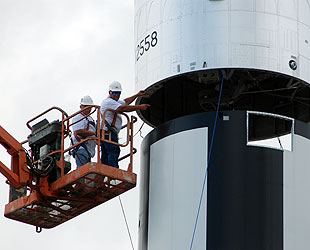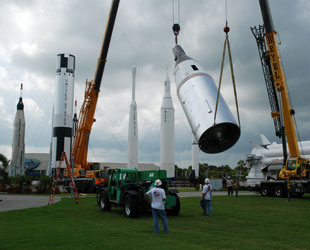Photo Gallery: Gemini-Titan rejoins Rocket Garden
Removed for a routine inspection in 2006 but deemed too far gone to be refurbished, the earlier replica was shipped in June to Johnson Space Center in Houston, Texas, in anticipation of the new Titan taking its place.
The garden whole again, curator Daniel Gruenbaum said in an interview with collectSPACE that the Gemini-Titan was not just another booster added to the collection, but an important piece for telling the history of the United States in space.
"That poor unsung hero of the early NASA programs," he said, referring to the ten manned Gemini missions that flew in 1965 and 1966. "Mercury proved that we could go to space and live but Gemini proved that we can live in space, we can stay in space, we can walk in space, we can dock in space, we can rendezvous and dock, we can go to the moon."
"Gemini proved we could go to the moon. Apollo gets all the glory for going to the moon but we didn't know how to be in space and in the Gemini program we learned how to be in space," he said.
Re-staging the Gemini-Titan

Workers with Guard-Lee, Inc. work to mate the first and second stages of the refurbished Titan II rocket. (collectSPACE) |
The newly-erected Gemini-Titan is a more accurate replica of the rocket than what previously stood in its place.
"We had a model of a Gemini-Titan that sat in the Rocket Garden for many years — over 20 years. It was a mockup of two first stages of Titan I vehicles, which are similar [to the Titan II that launched Gemini] but different," explained Gruenbaum.
As part of their regular maintenance program, the center's staff removed the original Gemini-Titan for inspection four years ago.
"It was pretty rough, structurally. It was going to take a lot of effort to rebuild it," recalled Gruenbaum.
As it turned out though, rebuilding wasn't the only option. Through a contact he made at Lockheed Martin in Denver, Gruenbaum learned of a potential replacement — one that would be historically more accurate.
"Through some long negotiations, first with the Air Force space and missile office and then the General Services Administration — the government property arm — we were able to obtain an actual Titan II launch vehicle and we put a Gemini capsule on it," he said.
The Titan II missile was among a group of 18 held at the Aerospace Maintenance and Regeneration Group, the Air Force's boneyard, in Tucson, Arizona. All 18 rockets were scheduled to be shredded and recycled as scrap metal.
"It was just almost two years to actually acquire. It was arduous to get an agreement to get this vehicle to be transferred to NASA. It's now a NASA vehicle, it is not on loan," Gruenbaum told collectSPACE.
Obtaining the Titan was only half the challenge though. The rocket had been demilitarized by the Department of Defense, which resulted in sections of the booster being removed and parts being disassembled.
The visitor complex turned to Guard-Lee, a manufacturer of aerospace replicas and restorations in nearby Apopka, Florida, to convert the intercontinental ballistic missile into a replica of the man-rated rocket that launched the United States' first two-person crews.
A significant part of that work — which ultimately took 20 months to complete — required adapting a spare interstage section to patch three areas of the Titan's stages that had been cut away to remove asbestos and other hazardous materials.
And then there were the engines.
"When we received them, they were all disassembled," explained Tom Wilkes, president of Guard-Lee. "So we had to go to original schematics and things like that."
Wilkes and his team referred to vintage documents and archival photos to ensure that the two LR-87 first stage engines were assembled correctly.
"Since the second stage engine doesn't show, we elected not to try to build a second stage engine," Gruenbaum said, referring to the single LR-91 that pushed the Gemini spacecraft into orbit.
Mirroring space history

The restored second stage of a Titan II, complete with mockup Gemini, is hoisted toward its first stage. (collectSPACE) |
The end result is an authentic display that Wilkes said not only represents the vehicle well, but also the way in which the U.S. approached its early manned spaceflight efforts.
"From engines up to the very top of the second stage is a warbird of the past. We built a replica Gemini to put on top of it. But in a way, that mirrors what happened in the Cold War-era, because when it came time to launch men in space, we turned to our military boosters to do that," said Wilkes. "These things kind of mirror that because almost all the boosters are military origin and they are artifacts — they just happen to have replica payloads on the top."
According to Wilkes, the Gemini-Titan now standing in the Kennedy Space Center Visitor Complex's Rocket Garden also mirrors all the Gemini-Titan launch vehicles launched during the mid-1960s program.
"We modeled it off of Gemini 3 but if you line up Gemini boosters across and try to pick one for a specific mission, it is really hard. You have to look for the serial numbers. There were not too many differences."
